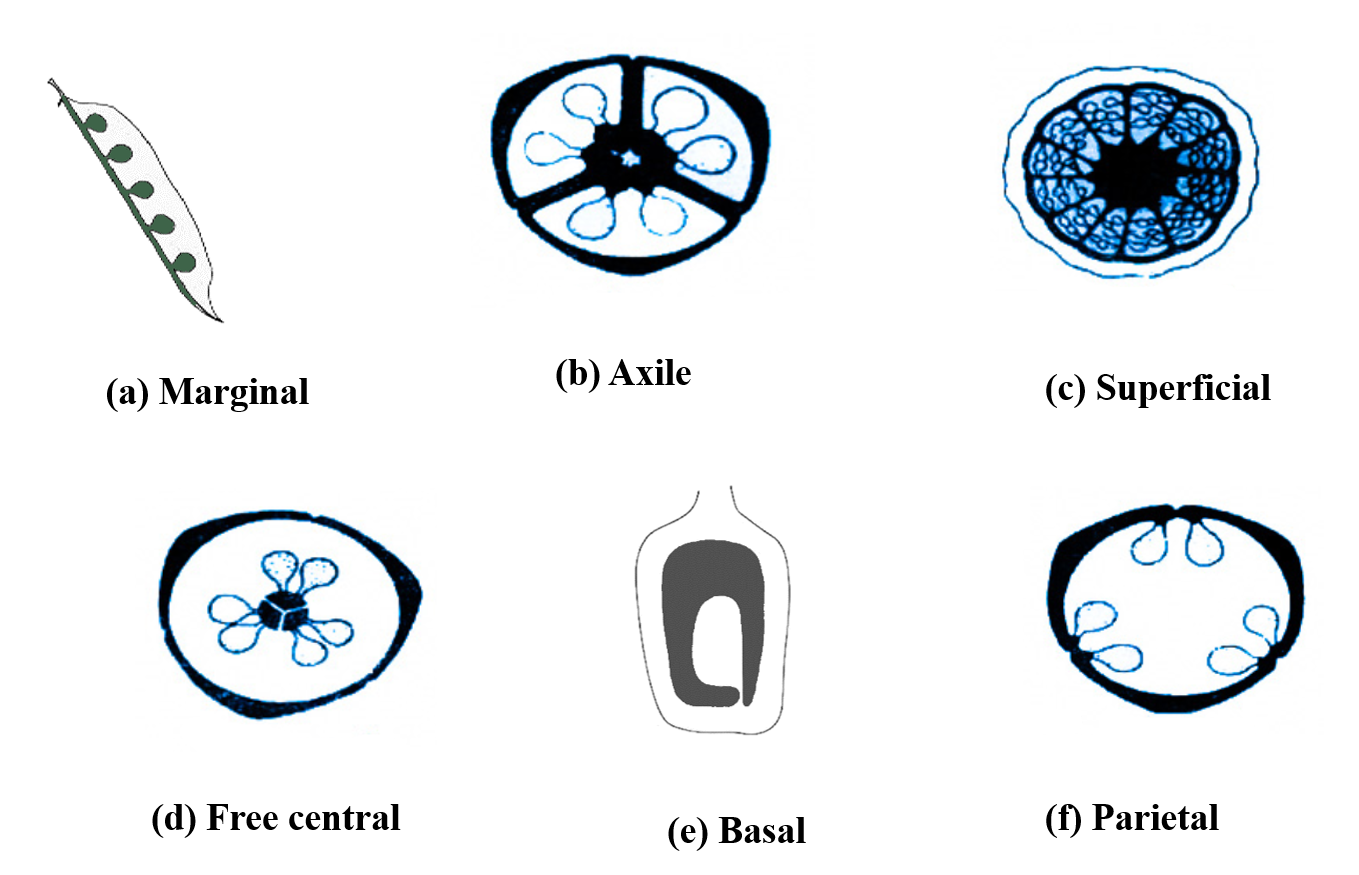
The type of placentation seen in cucumber is
(a)Basal
(b)Parietal
(c)Axile
(d)Marginal
Answer
483.6k+ views
Hint: The ovary present in cucumber bears a false septum (derived from the thalamus) which makes the ovary bilocular.
Complete Answer:
Placentation is defined as the arrangement of the placenta in the ovary of a flower. The placenta connects the ovules with the wall of the ovary. The type of placentation seen in cucumber is Parietal.
Additional Information:
The types of Placentation are-
Marginal placentation- In marginal placentation, the placenta forms a ridge along the ventral suture of the ovary and the ovules develop on it making two separate rows. This type of placentation is found in pea plants.
Parietal placentation- In parietal placentation, the ovules develop on the inner walls of the ovary. It is found in cucumber, etc.
Axile placentation- In axile placentation, the placenta lies on a central axis and ovules are attached to it. The ovary is segmented by fibrous septa. It is found in China rose, lemon, and tomato.
Basal placentation- In basal placentation, the placenta develops from its base and a single ovule is found attached to the base. It is found in the Asteraceae family that consists of marigold, sunflower, etc.
Free central placentation- In free central placentation, the ovules are present on the central axis. There is no formation of septa. It is found in Dianthus and primrose.

So, the correct answer is 'Parietal'.
Note: -The ovules inside a flower's ovary are attached via funiculi, the plant part equivalent to an umbilical cord in human beings. The part of the ovary where the funiculus attaches is known as the placenta.
-Placentation is meant for the transfer of nutrients, respiratory gases, and water from maternal tissue to the growing embryo, and also for the removal of waste from the embryo.
-Some plants have a special type of placentation known as Superficial placentation where the ovules develop over the entire inner surface of the carpels. It generally occurs in a multicarpellary ovary, e.g., Nymphaea.
Complete Answer:
Placentation is defined as the arrangement of the placenta in the ovary of a flower. The placenta connects the ovules with the wall of the ovary. The type of placentation seen in cucumber is Parietal.
Additional Information:
The types of Placentation are-
Marginal placentation- In marginal placentation, the placenta forms a ridge along the ventral suture of the ovary and the ovules develop on it making two separate rows. This type of placentation is found in pea plants.
Parietal placentation- In parietal placentation, the ovules develop on the inner walls of the ovary. It is found in cucumber, etc.
Axile placentation- In axile placentation, the placenta lies on a central axis and ovules are attached to it. The ovary is segmented by fibrous septa. It is found in China rose, lemon, and tomato.
Basal placentation- In basal placentation, the placenta develops from its base and a single ovule is found attached to the base. It is found in the Asteraceae family that consists of marigold, sunflower, etc.
Free central placentation- In free central placentation, the ovules are present on the central axis. There is no formation of septa. It is found in Dianthus and primrose.

So, the correct answer is 'Parietal'.
Note: -The ovules inside a flower's ovary are attached via funiculi, the plant part equivalent to an umbilical cord in human beings. The part of the ovary where the funiculus attaches is known as the placenta.
-Placentation is meant for the transfer of nutrients, respiratory gases, and water from maternal tissue to the growing embryo, and also for the removal of waste from the embryo.
-Some plants have a special type of placentation known as Superficial placentation where the ovules develop over the entire inner surface of the carpels. It generally occurs in a multicarpellary ovary, e.g., Nymphaea.
Recently Updated Pages
Can anyone list 10 advantages and disadvantages of friction

What are the Components of Financial System?

How do you arrange NH4 + BF3 H2O C2H2 in increasing class 11 chemistry CBSE

Is H mCT and q mCT the same thing If so which is more class 11 chemistry CBSE

What are the possible quantum number for the last outermost class 11 chemistry CBSE

Is C2 paramagnetic or diamagnetic class 11 chemistry CBSE

Trending doubts
Which is not a source of freshwater 1 Glaciers and class 11 chemistry CBSE

10 examples of friction in our daily life

The correct order of melting point of 14th group elements class 11 chemistry CBSE

Difference Between Prokaryotic Cells and Eukaryotic Cells

One Metric ton is equal to kg A 10000 B 1000 C 100 class 11 physics CBSE

What is the specific heat capacity of ice water and class 11 physics CBSE




